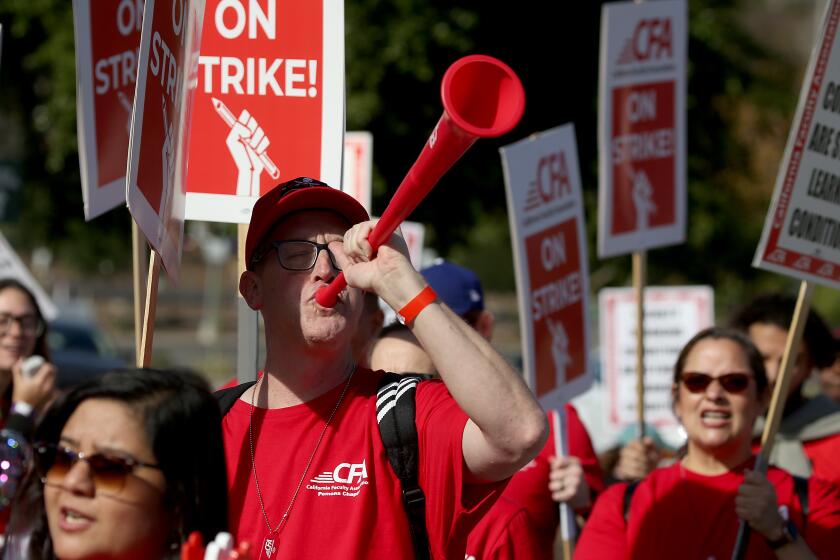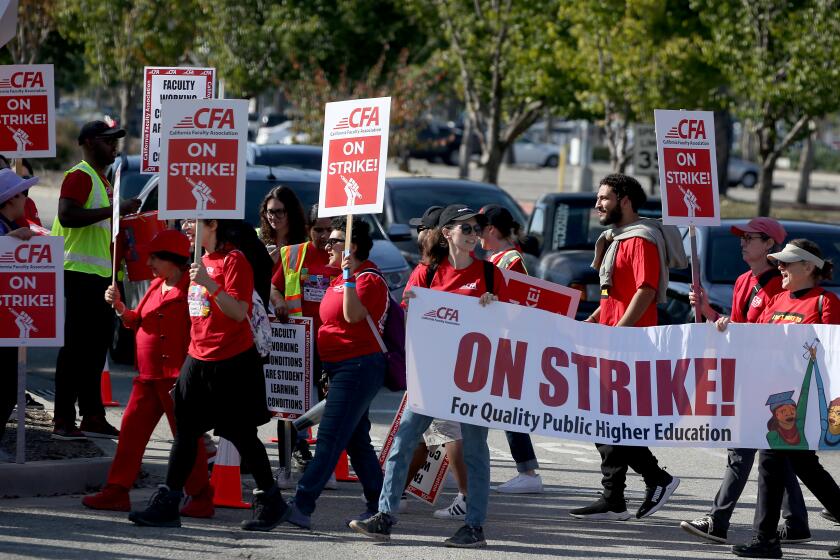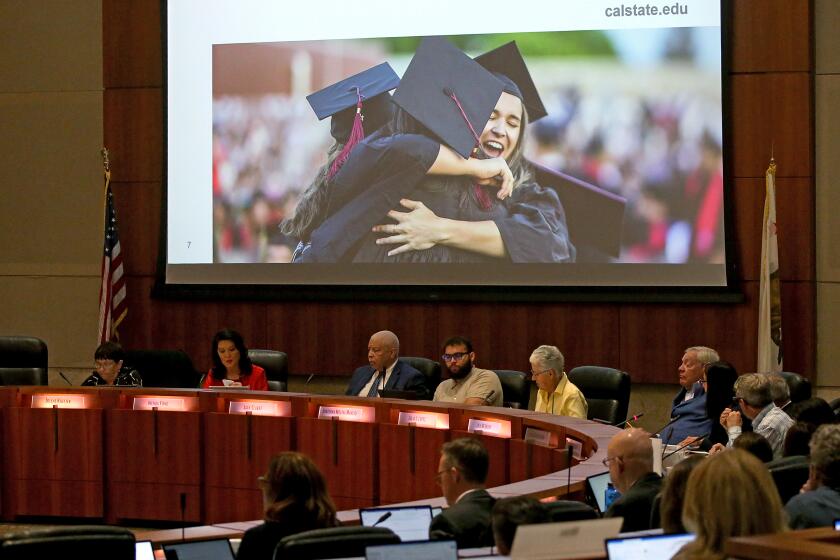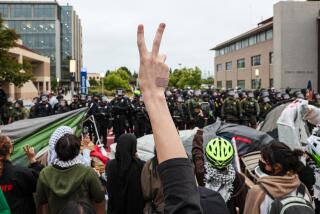CSU and faculty reach surprise tentative agreement, ending massive strike after one day

- Share via
The union representing California State University faculty reached a tentative agreement with the university system late Monday, putting an end to a planned five-day strike after one day.
“In case anyone forgot, STRIKES WORK! After months of negotiations and two strike actions, our movement for a #betterCSU has paid off!” the union announced on Instagram.
Faculty are expected to resume teaching Tuesday and students were advised to look for messages from their instructors. The agreement, which must be ratified by union members, includes higher salary floors for the lowest-paid workers, safer workplaces and an expansion of parental leave. In an email to faculty members, union leaders said the agreement includes a 5% salary increase retroactive to July 1, 2023, among other benefits.
“I am extremely pleased and deeply appreciative that we have reached common ground with CFA that will end the strike immediately,” CSU Chancellor Mildred García said in a statement. “The agreement enables the CSU to fairly compensate its valued, world-class faculty while protecting the university system’s long-term financial sustainability.”
The unanticipated announcement came after faculty at all 23 campuses of CSU, the nation’s largest four-year university system, staged a massive walkout Monday, the first day of the term for most students.
While faculty members marched in chilly rain throughout much of the state, students navigated a dizzying mix of instructions: Classes are canceled, classes are temporarily on Zoom, class is in session; assignments are online, assignments are scratched for a week. Official email communication with professors was cut, leaving some unsure if classes were taking place.
Neither university administrators nor the union had an official tally of the number of shuttered classrooms. But students throughout the system said faculty did not show up to most, if not all, of their classes.
The university said it did not cancel classes and clarified what it called “misinformation” about the status of instruction.
“Classes are not canceled. Individual faculty members who decide to strike will cancel their own classes,” a message said Monday. “If students have not heard from their instructor that their class is canceled, they should assume that it is being held as scheduled and go to class.”
The raise does not end the divide over pay between the faculty union and CSU, a dispute that had reached an apex in recent weeks, with one-day strikes at four campuses in early December.
The message said the two sides were “in communication with each other over the weekend” but did not share details.
The strike by the California Faculty Assn., which represents 29,000 professors, lecturers, counselors, librarians and coaches, culminated months of increasing tension between the union and CSU administration. It was the latest California walkout in higher education and TK-12 school districts as faculty and other workers — many stressed or burned out after the pandemic years — have demanded higher salaries amid escalating costs of living.
Just over a year ago, about 48,000 University of California academic workers, teaching assistants, researchers and postdoctoral scholars walked out for about five weeks, ultimately winning significant improvements in wages and working conditions. The Los Angeles Unified School District shut down for three days in March 2023, when teachers walked off the job in solidarity with school support staff, who won pay increases. A month later, L.A. teachers agreed to a contract that provides a 21% wage increase over about three years, averting a second strike.
Union demands
The CSU faculty union had pushed for an across-the-board, 12% wage increase for the 2023-24 academic year and wanted to raise the minimum salary for full-time faculty to $64,360 from $54,360. The union also sought improvements such as smaller class sizes, gender-inclusive restrooms and a full semester of expanded parental leave.
The tentative agreement falls short of the full slate of demands. In addition to the retroactive pay, the agreement includes another 5% increase on July 1 that is contingent on state funding. It raises the minimum salary for faculty by $3,000, increases paid parental leave from six to 10 weeks and improves access to gender-inclusive restrooms and lactation spaces, the email said.
It also extends the current contract, which was slated to end in June, by one year.
“This historic agreement was won because of members’ solidarity, collective action, bravery, and love for each other and our students,” said Antonio Gallo, an associate vice president of lecturers, in the email. “This is what People Power looks like. This deal immensely improves working conditions for faculty and strengthens learning conditions for students.”
During week-long, rolling walk-outs at four California State University campuses, faculty highlighted the tenuous working conditions of lecturers, who are a backbone of instruction but ineligible for tenure.
Scenes on campus
The one-day strike left CSU campuses nearly empty.
About a dozen people lingered in the Cal State L.A. student union in the morning, as faculty members in red ponchos picketed outside. The normally crowded campus Starbucks was devoid of customers.
“Normally the line would be out the door,” said Jordyn O’Connell, a student who works as a barista.
All of O’Connell’s classes had been canceled because of the strike. The 20-year-old psychology major supported the strike but had been looking forward to resuming classes after the winter break.
California State University was rocked by sexual misconduct scandals. Its most powerful leaders — the Board of Trustees — were not held accountable.
“I’ve been really eager to get back,” she said. “I just hope that we get this figured out. I’m ready to start the semester.”
For some students, it was not clear which classes were canceled. Moments before heading into the student center at Cal State Fullerton on Monday, Leslie Segundo, an arts major, learned that a professor who had been scheduled to teach one of her classes had moved the start date to next week because of the strike.
Segundo hadn’t heard from all of her professors and assumed that those who had not emailed her were going to hold classes.
“I will attend the classes that are available,” said Segundo, who commutes to campus from Orange. “As far as the teachers that are on strike, they haven’t emailed me in clear detail about it. I don’t think I’ve been assigned any readings.”
Around lunchtime, Karen Carrillo, president of the Associated Students Inc. at Fresno State University, said there wasn’t a typical rush at the campus food court. Three of her five professors canceled classes this week, a move she supported.
“We are still learning, even if it’s not in the classroom,” Carrillo said. “We’re learning from professors how to lead by example and how to fight for what they believe is right.”
Michael Lee-Chang, a second-year student at Sacramento State, said the campus looked like a ghost town. A friend sent him a picture of one class in progress; the only people in the room were the student and the professor. Lee-Chang said he feels that most students support the strike.
Cal State officials had circulated online forms, asking students to report classes that were canceled. Lee-Chang said many were reluctant to “snitch on their faculty, because it’s faculty they know and care about.” Some students were filling in the forms with spam, reporting on the status of fictional classes such as “Evil 101.”
The rain did not keep Stevie Ruiz, a Cal State Northridge professor in the Chicana and Chicano studies department, from protesting. He said the vast majority of students stayed away from campus. Ruiz added that about half of Northridge’s student body is Latino, and many are the first in their families to attend college.
“This is a working-class struggle. We’ve been really amazed by the outpouring of support from students. What happens to us affects them,” he said. “They care about us, and we care about them.”
More to Read
Sign up for Essential California
The most important California stories and recommendations in your inbox every morning.
You may occasionally receive promotional content from the Los Angeles Times.
















